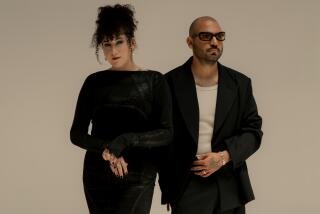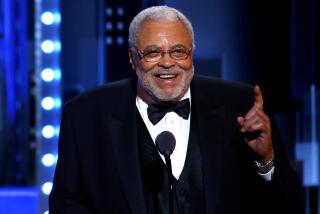JONES, ZANE SHARE ‘SECRET’
One New York critic wrote about their hair stylist before even discussing their choreography, but Bill T. Jones and Arnie Zane don’t care. By now, they’re in seventh heaven with the premiere of their latest choreographic collaboration, “Secret Pastures,” to be seen at Wadsworth Theater on Saturday as part of the UCLA “New Directions in Dance” series.
On a separate Friday program, the duo will present “Freedom of Information,” a pure-dance piece with music by David Cunningham and scenery by Gretchen Bender. But it’s “Secret Pastures” that represents a definite departure for Jones and Zane. This time these avant-garde dance artists mean to connect with a larger, more popular audience and have used star power, style and storytelling to capture our attention.
The dance features a setting by the graffiti artist and painter Keith Haring--making his debut as a stage designer--plus a score by new music whiz Peter Gordon and revealing day-glo costumes by Coty Award-winning fashion designer Willi Smith (the Willi of WilliWear clothes).
And then there’s that hair stylist, Marcel Fieve: “a true artist,” says Jones, in response to the critic’s disparaging comments.
But the stars of the show are really Jones and Zane and their young company of 10 dancers.
“People have talked about ‘Secret Pastures’ as ‘quasi-narrative’ and ‘dance characterization,’ ” says Jones, “but really it’s just a chance for us to hang out all of our choreographic devices and predilections for theatricality in a more realized fashion.”
No doubt the secret lies in the packaging of such disparate elements in a somewhat silly tale upon which the dancing precariously dangles.
Dressed in a white fright wig and long lab coat, Zane plays a shortish professor--according to the libretto, a former vaudevillian--who is somehow forced to take with him on an expedition to the South Atlantic a character known to us as the Fabricated Man, danced by Jones.
“There’s a kind of metaphor, almost a joke going on between Arnie and myself,” says Jones. “It’s a kind of device that says a lot about how people learn about class, race and sex. My character has great power and strength, but all he wants is to be cuddled like a child. It’s me in terms of characterization, exploring issues of vulnerability, but also me trying to own up to something I’m really about: I’m an improvisational artist. The character is really just a child wanting to dance and perform as if the world were being revealed to him for the first time. It’s really very personal.”
For Jones, however, being personal in performance is nothing new. The son of a migrant farm worker, he began college as a champion athlete and actor who always knew he had the showman’s bug. In 1971 he met Zane, who was at that time working as an art photographer (most recently, Zane’s dance photos have appeared in Vogue).
Their early work was small in scale--striking visual tableaux based in contact improvisation, often laced with scathing autobiographical diatribes on politics, race and sexuality--but over the course of 14 years of collaboration their dances have become increasingly concerned with conveying a sense of craft. Along the way, they have worked with artists as disparate as Louise Nevelson and Robert Longo.
In 1983, Jones set a dance (“Fever Swamp”) on the Alvin Ailey company. A second work has been commissioned for later this year. Today, Jones and Zane live half their lives on the road and the other half at a cottage outside New York City.
Don’t come to “Secret Pastures” expecting Jones to perform the improvisational rants he became known for 10 years ago. “I can still do that,” says Jones, “but it doesn’t serve me or the company well at this point.” Zane concurs, saying that while the improvisational work they did early in their careers is still important, “it’s high-risk entertainment and really not very popular artistically.”
Recently the pair has been in the forefront of those choreographers reaching out for ever broader audiences. Indeed, they lust after the opportunity to choreograph a Broadway show. Some, of course, are critical of this attempt--Jones and Zane, they say, are placing too much emphasis on “fashion” and not enough on choreography.
To Jones and Zane, however, the charge has about as much accuracy as similar responses to their earlier works in which they were persistently stereotyped as artists whose sole concern was with spilling their guts about their racial backgrounds.
“I wouldn’t apologize for making too much glamour so that you couldn’t see the choreography,” says Jones, noting that Jean Cocteau and Sergei Diaghilev were also accused of having turned “Le Train Bleu” into a fashion statement; it is now considered a modernist classic.
Arnie Zane puts this attitude another way: “Choreography is the center of what we do, but let’s face it: We produce the event--and that’s also choreography.”
More to Read
The biggest entertainment stories
Get our big stories about Hollywood, film, television, music, arts, culture and more right in your inbox as soon as they publish.
You may occasionally receive promotional content from the Los Angeles Times.










